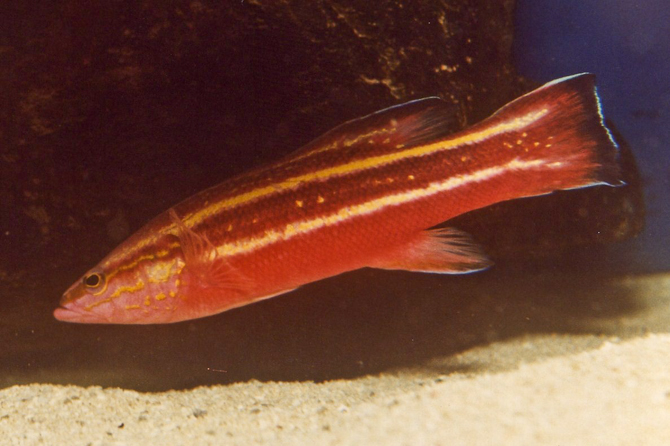
The Liopopoma fasciatum above and the Achilles Goldrim Hybrid surgeonfish below are evidence that it was possible to get very neat and rare fish even if you were an aquarist working at the Steinhart Aquarium back in the 70s and 80s. The aquariums might look different but the species are the same.
Sure the bare coral aquascape might leave a lot to be desired but dead coral skeletons was the norm back then. Gotta hand it to the Steinhart though, we’ve seen dozens of wrasse basses before but never it’s giant counterpart L. fasciatum from the Pacific before and the goldrim x achilles hybrid below is probably the oldest known photo of that particular cross. Let’s hope these photos can inspire Matt, Rich, Charles and Bart not only top these exhibits but perhaps they can even recreate a nostalgic tank with the huge L. fasciatum, giant jawfish and the falcifer butterflyfish.
Kevin Cheung is an enthusiastic photographer and he recently saw fit to scan his slide film images of these very neat historical photographs. We’ve selected a few of the more interesting images which are posted after the break, huge thanks to Kevin Cheung for granting us the use of his images to share with you, many more in his flickR album.

This adolescent cortez angelfish, Pomacanthus zonipectus is at the point where it’s changing colors are at their best.

Not sure who thought this pair of fish would work out but guess they did, at least for a while. The Giant Jawfish looks like he could snack down this falcifer butterflyfish with one snap of his jaws.

The color on this bicolor anthias isn’t half bad considering the food that was available back then. Can’t say the same for the faded clown triggerfish in the background though.

We can’t have a retro marine fish photo shoot without the old favorite, the Orbic batfish, Platax orbicularis.

Hey guess what? this regal blue tang is one of the most exotic fish in this photo session at the 70s-80s steinhart.

You know we had to throw in at least one freshwater fish in the mix. What we love about this image is that this is a wild-type discus which are all but absent in the discus hobby these days since all the solid blue diamonds, pidgeon bloods and red discus took over.




